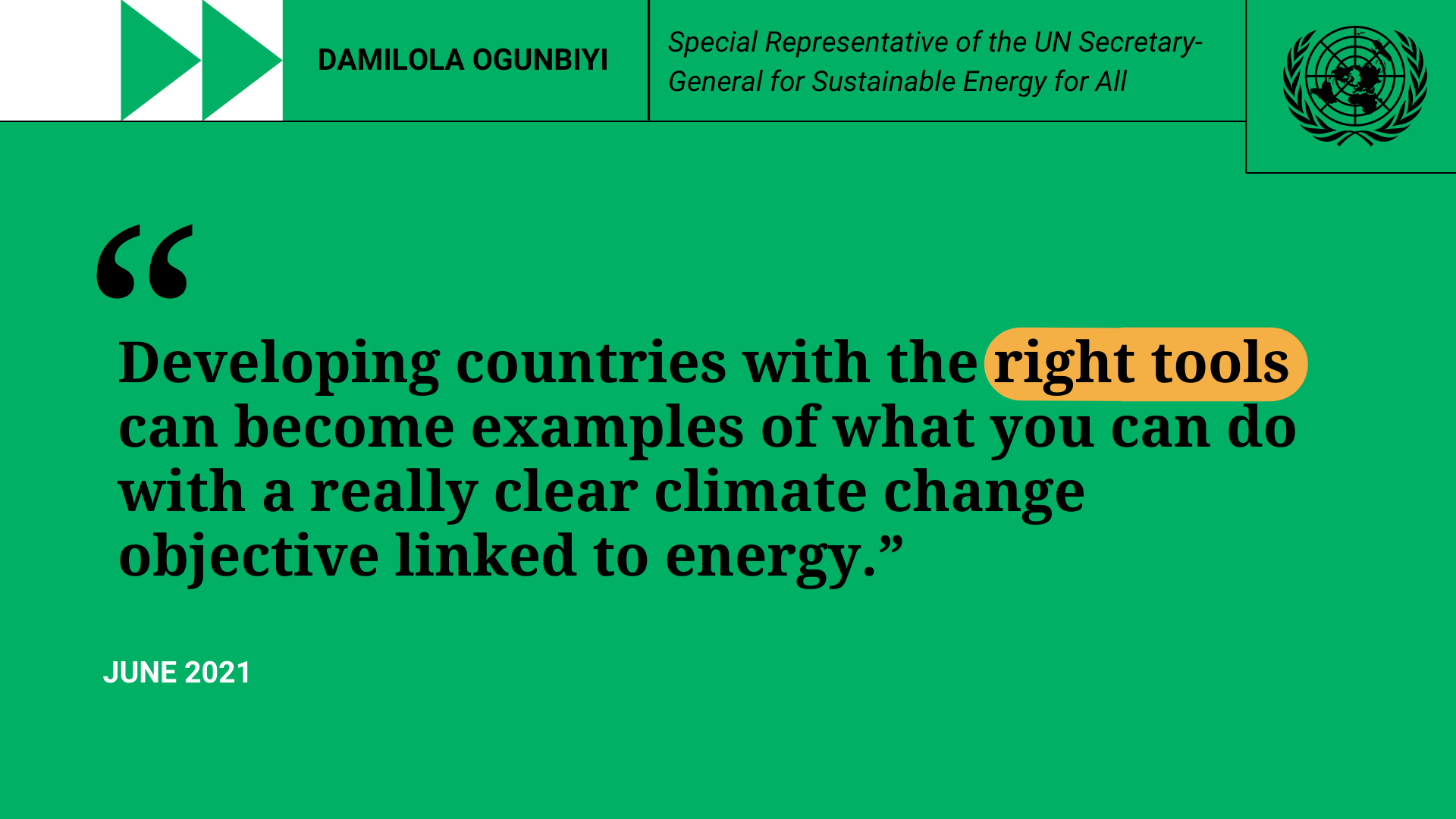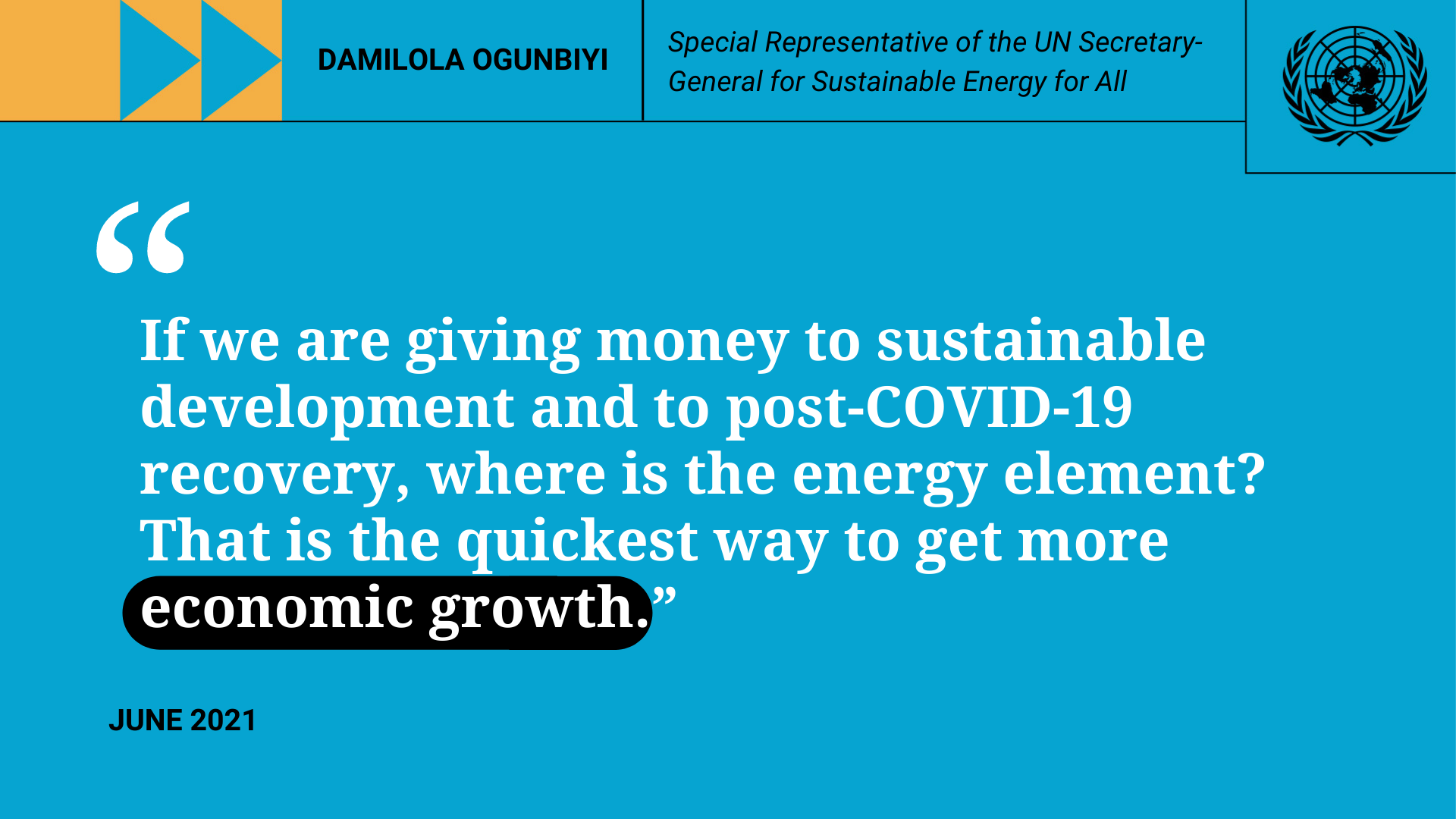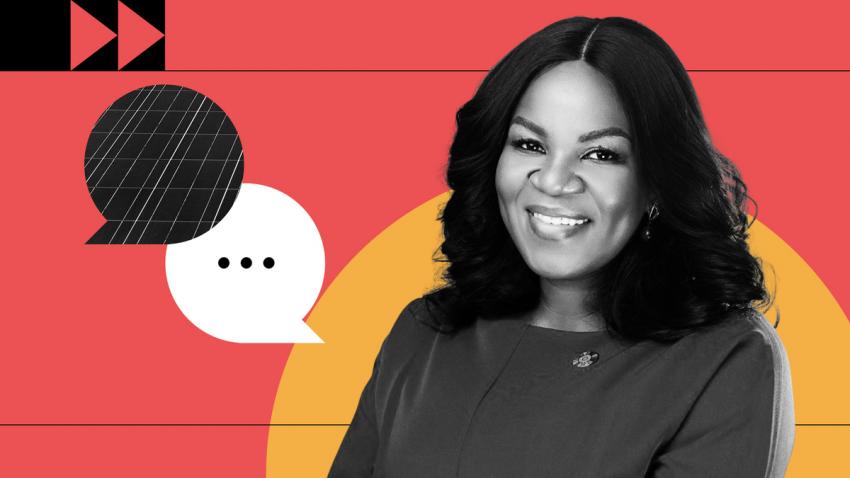As the Special Representative of the UN Secretary-General for Sustainable Energy for All, Damilola Ogunbiyi is passionate about ending energy poverty. With prior experience in running Nigeria’s Rural Electrification Agency, she knows firsthand that as long as people do not have adequate and clean energy, the world will not realize climate or sustainable development ambitions, and lives and livelihoods will be lost. Progress demands collective commitment and clear plans, tools and finance, with the upcoming high-level dialogue on energy offering a chance to mobilize action.
What is energy poverty?
Energy poverty is not having enough energy to make a difference in your life. Or not having energy at all. Almost 800 million people globally have no electricity, and about 2.6 billion, a third of the world’s population, have no access to clean cooking fuels. In COVID-19 times, such people cannot just stay home. They have no means of survival without enough energy to live comfortably in their households and thrive in their businesses.
We have to get everyone out of energy poverty, in line with Sustainable Development Goal (SDG) 7 on access to affordable, clean, sustainable energy. But COVID-19 has moved 150 million people back into extreme poverty, where they are more likely not to have energy. Or maybe they had a minimal amount and now have none at all. In Africa, only 24-25 percent of primary health-care facilities have electricity, a major problem for vaccine distribution.
In September, the General Assembly will hold a High-level Dialogue on Energy for the first time in 40 years. It is intended to explain just how important energy is to climate and sustainable development. We are looking for innovations and ideas because we are not on track in getting people out of energy poverty.
What’s the link to climate action?
If we do not achieve SDG7 by 2030, we cannot achieve net-zero greenhouse gas emissions by 2050. It will be scientifically and mathematically impossible. The way the trajectory is going now, by 2030, we will have 650 million people who still have no electricity. When we think about the Glasgow climate talks at the end of the year and the Nationally Determined Contributions (NDCs) under the Paris Agreement, energy has to be central to these.
Africa has a billion people. If you take out South Africa, people in sub-Saharan Africa are responsible for about 0.55 percent of global emissions. Their energy transition and economic growth should happen in a low-carbon way, but we also have to say exactly what are the energy transition plans. They do not have enough energy to start with. A billion people in Africa share a power production capacity of 81 gigawatts, which is what Germany produces every day.
There has to be a global effort to understand the needs of very poor and vulnerable countries and how to tackle these. Because you don’t want to come back in 10 or 20 years to transition their energy systems again. This has already taken decades in the Global North. Instead, we can almost start from scratch in a lot of developing countries. We know clean energy is the best thing for gross domestic product (GDP). We know it creates more jobs than traditional fossil fuels. Developing countries with the right tools can become examples of what you can do with a really clear climate change objective linked to energy, instead of what is happening now, where many of these countries are essentially victims of climate change.
Since you worked on rural electrification in Nigeria, what are some priorities in extending energy to rural areas?
It is unacceptable that 1.6 million people in the world die every year from fumes from burning fuels like charcoal to cook food. They need clean cookstoves and electricity or cleaner energy solutions to survive. That has to be a priority because the lack of clean energy not only harms the environment but kills woman and children. A lot of people think that the largest polluter in the developing world is industry. It is actually not. It is land use, and the cutting of trees and burning of charcoal.
It is critical to go into communities and understand how much energy they need to thrive. For a lot of women in rural Nigeria, their homes are also their businesses. So it is not okay to just hand them a solar lantern and tick a box. You need to know what they do. Do they need drying facilities for their yams or their cassavas? In Africa, if you give a woman sustainable clean energy she’s likely to earn 59 per cent more than she earned before, a huge leap. What we want is to have them become self-sufficient with adequate and sustainable energy so there is not this continuous cycle of aid and aid and aid, because that won’t work.

Where will clean energy finance come from?
All countries have to come together to sort this issue. In terms of investment in energy systems in developing countries, we need about $40 billion a year from now to 2030, yet Africa barely gets $4 billion and Asia about $10 billion. That shows the scale of the problem.
If we are giving money to sustainable development and to post-COVID-19 recovery, where is the energy element? That is the quickest way to get more economic growth. People may say I don’t care about climate. But the economics of energy works, and that’s the language we use when speaking to governments because they often care about jobs and GDP before you can have a climate conversation. It does not matter how you say it, as long as you are making the point for people and planet.
What do you expect from the High-level Dialogue on Energy?
It is putting energy on a different platform from before. What we are striving for are the Energy Compacts. Unlike a lot of compacts and declarations in the past, these are purely energy focused, aligned to net-zero emissions and the Paris Agreement and to national NDCs. They take the NDCs to another level. It a country says it is getting out of coal, that statement would be in the NDC. What we are asking for in the Compacts is exactly how will you do it and monitor it, every single year.
This is for all countries – and it is also about countries that want to support other countries. The United Kingdom could decide to have a compact to provide power for 10 million Asians. How do they plan to do this? It is a way to show tangible actions are happening. This may be about providing power to more people or energy efficiency or getting out of coal. There are many ways forward. But it has to be a global effort, because we are not on track with barely 10 years to go on the SDGs. We need firm agreements holding governments accountable. The private sector can also sign the Compacts, as can civil society and major initiatives. It is all about raising ambition and showing people that collectively this is a huge opportunity.
What part does the private sector play?
Governments should not be doing everything. The private sector should execute projects, either in large-scale renewables to go on the grid or decentralized energy solutions. What governments should focus on is creating an environment for the private sector to flourish. So that means having the required policies, regulations and subsidies, and being able to attract the right kind of private sector. That depends in part on having enough data for your country. It might sound very basic but some countries might not be able to tell you where their unelectrified population is. That type of granular information is critical to see what is the most cost-effective way to provide clean energy in your community or country.
In Africa, it has just been fantastic to see how we went from five energy developers on the continent to 100, and most of them are African. You need to look at developing local capacity and lending capacity when needed. But you have to create a market above all. The private sector is not going to come in without it. And you can’t blame them.
What’s the role of energy subsidies?
It depends on the country. In a country like mine, Nigeria, the subsidies should be focused on decentralized energy. If you connect a customer using a solar hybrid solution or a standalone solar solution, then you get your subsidy, but only post-connection. In large economies where they are trying to channel technology like green hydrogen, there might be a technology-based subsidy. So there has to be a place for subsidies, but how you use them depends on the geography, the policies of a country and so on. If we do not have energy subsidies at all, a billion people will really suffer from that decision. What is important is how you implement these subsidies and make sure that they have a line to Paris and an end date.

How do you define a just transition?
A just transition is a period when people go from a dirty fuel to a clean fuel, noting that a just transition for Africa may be completely different than in wealthy countries. In Africa, there is not enough energy and you are decarbonizing 0.55 percent (of emissions). What are you actually decarbonizing? What does that mean in the average sub-Saharan country? In Lagos City, let’s say I have an aunty who takes a highly polluting bus to work every day for three hours. She has been saving all her money to buy a little car that runs on petrol. But now we are telling African countries: Don’t buy that. You have to buy a Tesla, even though we don’t know how you are going to finance it.
The problem in this situation is, what is the clean energy offer? That is what we really need to tackle so a just energy transition can move faster and people will be with us. Right now, people in many places still cannot see the horizon beyond oil and gas. It is not just about the power sector, but about transportation and how they earn their money. For a lot of countries, revenues from fossil fuels keep them afloat. What are the alternatives? How they still get to their economic growth targets? How they make sure that their people are healthy with the right energy systems?
For me, a just transition is sitting down with governments and understanding their issues, helping them plan how to get to a path of net zero, and articulating, with data, with math, with science, what is the last possible date they have to stop using every single fuel in their arsenal. When can they transfer to renewables and what kinds of backup systems do they have?
What about jobs?
You can get 3.5 times more jobs in renewable energy than the fossil fuel equivalent. But you have to create systems and projects to develop these jobs. You have to make sure that if you are telling people in a coal-dependent community that the entire country is moving to renewables, you are training them from now. You are not going to take 1 or 2 million people and make them redundant. You have to think about labour laws and change all sorts of different issues in a just transition conversation.
COVID-19 recovery plans have been criticized for not being strong enough on abandoning fossil fuels. Was that a lost opportunity?
The word “fossil fuels” has to be dissected a little. If you are transitioning from coal to gas to renewables – that is different from saying all fossil fuel is bad. A lot more could have gone into energy poverty, which I’m really hoping will still happen. Renewables are the cleanest way but I don’t think anyone should be dictating next steps. You can’t just look at it with the developed world having all the money and the developing world expected to just leap forward, somehow. That does not make any sense.

There are some indications that women are thriving in renewable energy industries, more so than in traditional ones.
I’m a bit biased because I trained 600 young women who are doing amazing things in renewable energy right now. The beauty of renewable energy is there are so many things you can do. So there are solar technicians and planners and engineers, the payment collector, the IT integrator. It is not like back in the day, like me, where you have a pure power systems engineering background. In renewable energy, you come in with a STEM (science, technology, engineering and math) subject and really thrive. There are also policies to implement. When I was in Nigeria, if the gender balance in an energy company was not at least 40 per cent women, it could not get subsidies.
We need to train young women to make sure they are employable. It is not just going to happen for women – that’s not how the world works. We have to challenge the norms and create the opportunities. I don’t think enough countries understand the power they have in insisting that women have to be hired by renewable energy companies. It is the same thing with race. You have a lot of big companies operating in Africa and none of them have a black or African representative. There are certain things we have to insist on.
Tell us a little more about the 600 young women.
That was amazing. We were working on building solar hybrid systems for universities, bigger decentralized systems of 10-15 megawatts. So I decided to train them in their final year of university. Before we did that, we consulted with all the renewable energy companies on what we should train them on to get jobs later on. A lot were hired, some set up businesses on their own, and two won awards.
That took only six months and hardly any money, and it was the most rewarding thing I’ve done in my life, to give that opportunity to young women. Because I was a young woman once, and if I did not get opportunities I would not be speaking to you right now. I think sometimes when we get into these roles we forget the importance of bringing people along with you so they have a voice and a seat at the table, and a better life moving forward.
Why are you so passionate about energy access?
When I was much younger, in my 20s, I had an opportunity to provide power to a baby hospital. Often when you think about energy access or not having it, you think about it as an inconvenience. I never understood that it could make the difference in a baby living or dying. I remember walking into the baby hospital, and all these people were clapping. The doctor came to me and said you know, it only takes seven seconds during a major operation for a woman or baby or both to die. That just stopped me. There is no power generator you can turn on in seven seconds.
When we talk about sustainable energy, for me, it is the difference between a mother or a baby living or dying. When we have these big forums, I always like to bring it down to the grass-roots level, because the decisions we make always affect the most vulnerable people. It doesn’t affect you and me. That keeps me going. If there is any job where you can save someone’s life, that is the best job you can do.
Every time it takes longer to make a decision or we procrastinate on finding the perfect solution, which doesn’t exist, people are suffering and dying. That is the reality. So we need to work harder and faster. We have the solutions to make sure that everyone gets adequate power in a clean way. We just need to implement them now.




